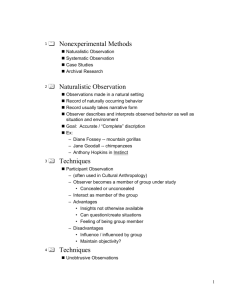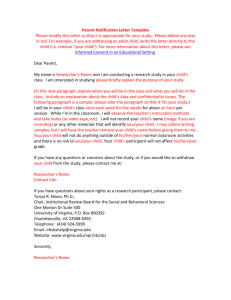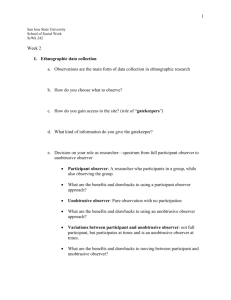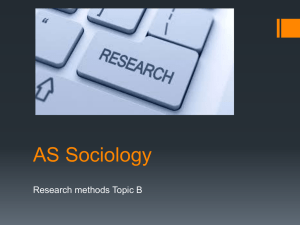Observation The starting point for any science is systematic
advertisement
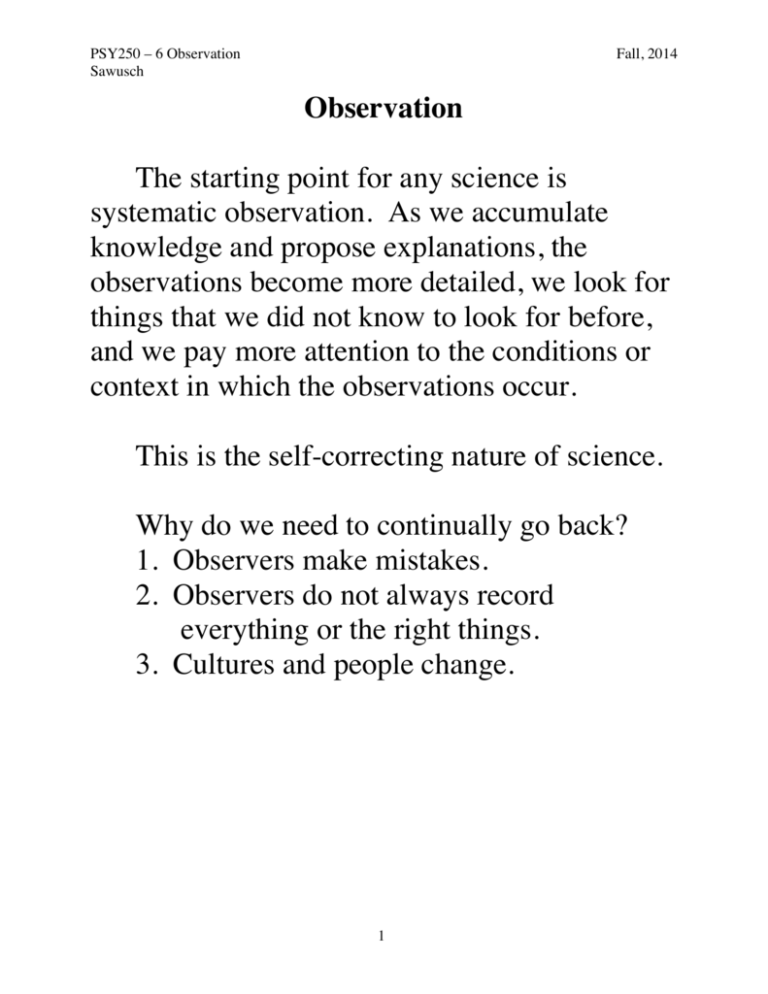
PSY250 – 6 Observation Sawusch Fall, 2014 Observation The starting point for any science is systematic observation. As we accumulate knowledge and propose explanations, the observations become more detailed, we look for things that we did not know to look for before, and we pay more attention to the conditions or context in which the observations occur. This is the self-correcting nature of science. Why do we need to continually go back? 1. Observers make mistakes. 2. Observers do not always record everything or the right things. 3. Cultures and people change. 1 PSY250 – 6 Observation Sawusch Fall, 2014 Descriptive/Observational Methods 1. Naturalistic observation - observe and record occurrence of naturally occurring behavior 2. Systematic observation – observe and record occurrence of certain specific (naturally occurring) behaviors 3. Case study - Gather detailed information about one individual 4. Archival research – use existing records to establish occurrence of behavior With each type of approach, we will consider the advantages and the potential problems and limits of each approach. 2 PSY250 – 6 Observation Sawusch Fall, 2014 I. Naturalistic Observation Record behavior of subjects. Approach is qualitative in most instances and based on descriptions of events and settings. Researcher attempts to record “everything” relevant: the setting, people’s reactions to events, patterns of contact among people, etc. Key issue - What to observe. You can not record everything. Humans are limited in how much information they can process at once. Even a video camera does not record everything and what it does record may be far more than can be analyzed. Limit observations to behavior and settings relevant to questions under investigation. To examine real-world problem solving, you would limit observations to person’s behavior when answering questions or otherwise interacting with people or modifying their environment. 3 PSY250 – 6 Observation Sawusch Fall, 2014 A) Why this approach? - Advantages 1. It is often the first approach when investigating a new area of inquiry. Before you can use the other methods, you need to know something about what people (or animals) do under different circumstances. 2. It is what happens in the real world. B) Potential problems & limitations 1. Subject reactivity – Participant changes their behavior because they are being observed. As an observer, you can be an outsider with either the participants knowing that you are making observations or with your role concealed (unobtrusive observation). 4 PSY250 – 6 Observation Sawusch Fall, 2014 Alternatively, you can be a participant observer and the other participants can either know that you are making observations or your role can be concealed. Being an active participant can lead to the researcher being accepted as one of the group. This leads to situations and behavior which are more “natural” and helps to reduce reactivity. It can also assist the researcher because their participation leads to a better understanding of the environment and participants. This, in turn, makes it easier to construct and test explanations for the data. Being a participant observer can also lead the researcher to identify with individuals they are observing. This, in turn, can influence their observations and reduce the validity of data. Concealing your role and/or making the observations unobtrusively can minimize reactivity. 5 PSY250 – 6 Observation Sawusch Fall, 2014 2. This approach is not as useful for studying well specified, detailed questions. It relies on naturally occurring events and behavior and the critical events or behavior may not occur during the periods of observation. 3. The approach is very time consuming. First, it takes time to make the observations. Second, it takes time to code the observations into useful data. Third, to construct and test explanations, the researcher must repeatedly go through the data and distinguish important from unimportant events and recheck the explanations against the data. They may have to go back to the observations and re-code them. 6 PSY250 – 6 Observation Sawusch Fall, 2014 II. Systematic Observation Like naturalistic observation but with an emphasis on gathering quantitative data on a limited set of behaviors. This allows them to study and test specific hypotheses. A) The first step here is to develop a coding system. The coding system is a description of a set of behaviors that will be observed and how they will be recorded. Key idea - Delimit the range of behavior that you will observe. However, if this behavior is complex, how do you record it? Set up operational definitions of each behavior that will be recorded. Record occurrence (and duration) of each as it occurs. 7 PSY250 – 6 Observation Sawusch Fall, 2014 For example, to study social behavior in young children, we might start by defining 5 types of behavior: 1. Unoccupied 2. Solitary play 3. Together 4. Parallel play 5. Group play In ethology (study of animal behavior), this is called an ethogram. 8 PSY250 – 6 Observation Sawusch Fall, 2014 B) Potential problems 1. Remaining vigilant - Following an animal in its natural habitat is impossible. It is also difficult with human participants. Recording devices (audio, video) are often used to deal with this problem. 2. Reactivity – Humans and animals often change their behavior when they are being observed. The observer could take steps to remain unobtrusive or could become a participant observer. 3. Reliability – To ensure that the coding of behavior is accurate (consistent), two or more observers are used and their results are compared. This is inter-observer (or inter-rater) reliability. It is checked by a measure of agreement, such as a correlation coefficient. Values between 0.7 and 1.0 are good agreement. Values above 0.9 are preferred. 9 PSY250 – 6 Observation Sawusch Fall, 2014 4. Sampling – How do you know that your observations are representative of what happens in the real world? Set up a schedule of observation intervals. Use multiple observation intervals over the range of times (day, week, year) that are of interest. The sampling of time intervals is designed to be representative of the distribution of behavior over time. 10 PSY250 – 6 Observation Sawusch Fall, 2014 III. Case Study Follow a single individual and make detailed observations over time. A) Basics This allows a detailed inventory of behavior to be developed. It is particularly useful for studying unusual or rare events, such as that of “Sybil”, the woman with multiple personality disorder or “S”, an individual with extraordinary memory. However, like all observation of the natural world, this type of research can not answer many of the questions of causation (what led to a particular behavior), particularly if the cause is from before the period of observation. In addition, a lot of information is “retrospective”. It is based on the participant’s memory of the past, and is error prone. 11 PSY250 – 6 Observation Sawusch Fall, 2014 As an aid to sorting out causes, we could find a comparable case that does not have the same outcome. For example, to study the causes of schizophrenia, we could study identical twins with only one who developed the disorder. To study a case of amnesia (memory loss) in a person with a history of alcohol abuse, we would find a similar individual with no history of alcohol abuse. In situations where true experimental work is not possible, this may be the best way we have to study these types of (rare) phenomena. 12 PSY250 – 6 Observation Sawusch Fall, 2014 B) Potential problems 1. Reactivity – The participant knows that they are being observed and may alter their behavior. Since these studies often take place over a long time period, the researcher becomes a part of the individual’s life. Hopefully, this results in reduced reactivity. 2. Accuracy of recall – To the extent that part of the data is based on the participant’s recall of events, it will reflect the inaccuracies of memory. 13 PSY250 – 6 Observation Sawusch Fall, 2014 IV. Examples A) Case Study - Luria (1968) studied a man with exceptional memory abilities. This man could read long passages of prose or lists of items and then recall them perfectly. Even after days or months had passed, his memory for the lists or prose was excellent. This individual (known as S) said that his memory was based on imagery. This is a well known mnemonic strategy. S also had problems that arose from his incredible memory. He had difficulty concentrating on a task because images related to the task would come to mind. He had difficulty holding onto a job. 14 PSY250 – 6 Observation Sawusch Fall, 2014 B) Case Study - Piaget’s theory of cognitive development is grounded in his studies of his own children. Much of the work on language acquisition in children is based on case studies where the development of a child is followed over their first 6 or 7 years of life. In both of these examples, the case study method is well suited to collecting systematic observations over a period of time. 15 PSY250 – 6 Observation Sawusch Fall, 2014 C) Systematic Observation - Work of Perlmutter on memory in children. In laboratory experiments, 4 yr olds do better at remembering lists of words than 3 yr olds. However, this tells us little about the underlying nature and development of memory. Todd & Perlmutter (1980) used systematic observation with children. They observed and categorized the things that 3 and 4 yr olds talked about (coded their descriptions of memories). Results: Both 3 and 4 yr olds recalled many experiences and events. Differences in number of events were small. However, 4 yr olds recalled more details, more about their internal state (happiness, etc.), and recalled events further back in the past (over longer retention intervals). Thus, to some extent, the large differences in the laboratory overestimate the differences in memory for real world events for 3 and 4 yr olds. 16 PSY250 – 6 Observation Sawusch Fall, 2014 Two additional notes: 1. Validity - The experimenters checked with the parents on the events that the children were remembering. Accuracy was high for both ages. This addresses the issue of the “accuracy” of the children’s memory. 2. Reliability - The inter-rater reliability on coding the memories was high. 17 PSY250 – 6 Observation Sawusch Fall, 2014 V. Archival Research The researcher uses previously compiled records to answer questions. Examples are public records (such as court filings for divorce), published letters and diaries, and previous surveys. A) Types of archives 1. Statistical records – Census data, public health records, the test score records kept by companies such as the Educational Testing Service. If a question can be formulated as a potential relationship between variables that can be measured from the records, then this hypothesis can be tested. For example: Did the No Child Left Behind act lead to an increase in reading or math ability? 18 PSY250 – 6 Observation Sawusch Fall, 2014 2. Survey Archives – Major polling organizations, research institutes and universities make their survey data available. Since individual researchers often do not have the financial resources to conduct national surveys, these shared databases are an important source of information for research. 3. Published Records – Published diaries and letters, the material from radio, TV and newspaper stories, political speeches, blogs, and even the messages posted on internet bulletin boards. 19 PSY250 – 6 Observation Sawusch Fall, 2014 For example, peoples’ perceptions of the causes of problems can be examined using the newspaper columns from “Dear Abby” and “Ann Landers”. Schoeneman & Rubanowitz (1985) found that when people discussed themselves, the locus of problems was external (other people, events) but when people discussed others, the locus of problems was internal to the other. 20 PSY250 – 6 Observation Sawusch Fall, 2014 B) Content Analysis A coding scheme is devised that allows the researcher to quantify the information in a document. This is an operational definition of the information that belongs in each of a set of pre-defined categories. For example, to investigate the incidence of co-habitation before marriage, we could look at marriage licenses (public records) and tabulate whether the two people have the same address (co-habitation) or not. When using a coding scheme, inter-rater reliability should be checked. 21 PSY250 – 6 Observation Sawusch Fall, 2014 C) Potential problems: 1. The records for the question that we develop may not be readily available (lost, damaged, or only in paper form and hard to search through). 2. The accuracy of the information may be low. The people who gathered the information may not have done this with sufficient care (reliability). Also, some types of data may contain reactivity (people altering or censoring the information that they provide) and the degree to which this is the case is unknown (validity). 22 PSY250 – 6 Observation Sawusch Fall, 2014 VI. Summary - Advantages and Disadvantages of Observational Research A) Advantages 1. First step in an area of research. Build a database of observation from which explanations and hypotheses can be derived. 2. Sometimes only way to study phenomena that can not be reproduced in the laboratory. 3. Ecological validity. What is being studied is what the organism does in its own, natural environment. 23 PSY250 – 6 Observation Sawusch Fall, 2014 B) Disadvantages 1. We generally can not determine causal relationships (what events cause what other events). 2. Observations of rare events (e.g. case studies) can be difficult to reproduce/replicate. 3. We must guard against letting interpretation intrude into (or substitute for) accurate behavioral observation. This is a particular problem with attribution of human qualities to animals (anthropomorphizing), but can also happen when we substitute inference about internal states (feelings, motivation, etc.) for observations of behavior. 4. Subject reactivity. If subjects know they are being observed, their behavior may change. To the extent that this happens, we are not really observing “real-world” behavior. 24 PSY250 – 6 Observation Sawusch Fall, 2014 Sample Questions for Chapter 6 1. Observing and measuring the wear on floor tiles as an index of interest level in different museum exhibits is an example of: a) unobtrusive measurement b) subject reactivity c) intrusive measurement d) none of the above 2. What is the advantage of observational research? a) it allows researchers to build a database of observations about a previously unexplored question b) it is ecologically valid c) researchers can make causal statements about the behavior under investigation d) a & b above 3. In both case-study and naturalistic observation research, the investigator a) has a comparison or control group b) manipulates independent variables c) holds extraneous variables constant d) none of the above 25
